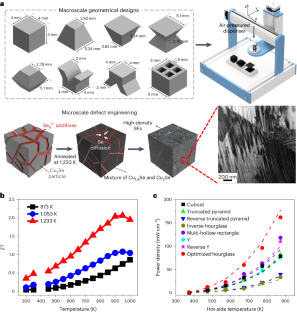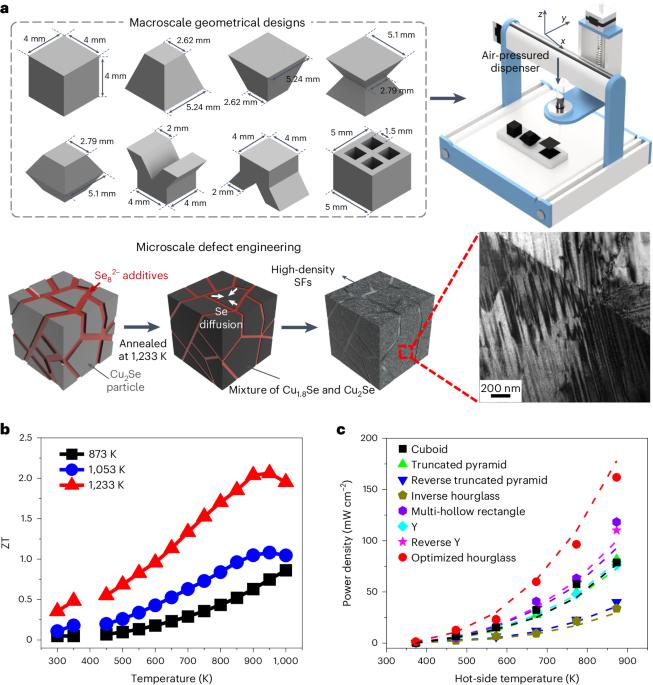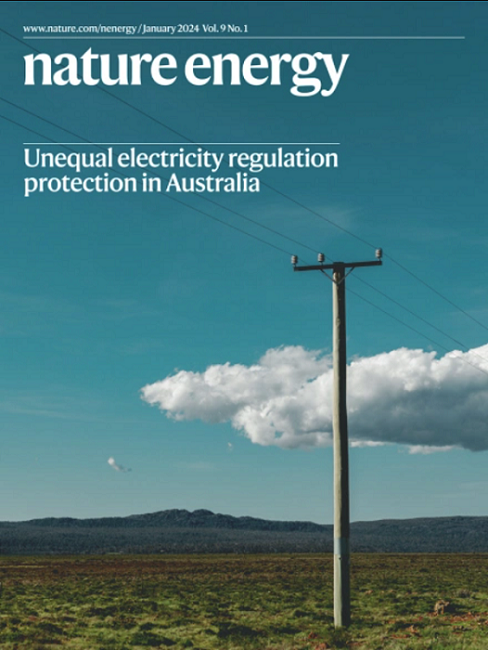Geometric design of Cu2Se-based thermoelectric materials for enhancing power generation
IF 49.7
1区 材料科学
Q1 ENERGY & FUELS
引用次数: 0
Abstract
Waste heat, an abundant energy source generated by both industries and nature, has the potential to be harnessed into electricity via thermoelectric power generation. The performance of thermoelectric modules, typically composed of cuboid-shaped materials, depends on both the materials’ intrinsic properties and the temperature difference created. Despite significant advancements in the development of efficient materials, macroscopic thermal designs capable of accommodating larger temperature differences have been largely underexplored because of the challenges associated with processing bulk thermoelectric materials. Here we present the design strategy for Cu2Se thermoelectric materials for high-temperature power generation using a combination of finite element modelling and 3D printing. The macroscopic geometries and microscopic defects in Cu2Se materials are precisely engineered by optimizing the 3D printing and post-treatment processes, leading to notable enhancements in the material efficiency and temperature difference across legs, where the hourglass geometry exhibits maximized output powers and efficiencies. The proposed approach paves the way for designing efficient thermoelectric power generators. Choo, Lee et al. computationally and experimentally investigate how the thermal resistance and surface cooling of thermoelectric legs with different geometries impact the power output of Cu2Se thermoelectric materials.


用于提高发电量的 Cu2Se 基热电材料的几何设计
废热是工业和自然界产生的一种丰富能源,有可能通过热电发电转化为电能。热电模块通常由立方体材料组成,其性能取决于材料的内在特性和所产生的温差。尽管在开发高效材料方面取得了重大进展,但能够容纳更大温差的宏观热设计在很大程度上仍未得到充分探索,原因是与加工块状热电材料相关的挑战。在此,我们结合有限元建模和三维打印技术,介绍了用于高温发电的 Cu2Se 热电材料的设计策略。通过优化三维打印和后处理工艺,Cu2Se 材料的宏观几何形状和微观缺陷得到了精确设计,从而显著提高了材料的效率和跨腿温差,其中沙漏几何形状表现出最大化的输出功率和效率。所提出的方法为设计高效热电发电机铺平了道路。
本文章由计算机程序翻译,如有差异,请以英文原文为准。
求助全文
约1分钟内获得全文
求助全文
来源期刊

Nature Energy
Energy-Energy Engineering and Power Technology
CiteScore
75.10
自引率
1.10%
发文量
193
期刊介绍:
Nature Energy is a monthly, online-only journal committed to showcasing the most impactful research on energy, covering everything from its generation and distribution to the societal implications of energy technologies and policies.
With a focus on exploring all facets of the ongoing energy discourse, Nature Energy delves into topics such as energy generation, storage, distribution, management, and the societal impacts of energy technologies and policies. Emphasizing studies that push the boundaries of knowledge and contribute to the development of next-generation solutions, the journal serves as a platform for the exchange of ideas among stakeholders at the forefront of the energy sector.
Maintaining the hallmark standards of the Nature brand, Nature Energy boasts a dedicated team of professional editors, a rigorous peer-review process, meticulous copy-editing and production, rapid publication times, and editorial independence.
In addition to original research articles, Nature Energy also publishes a range of content types, including Comments, Perspectives, Reviews, News & Views, Features, and Correspondence, covering a diverse array of disciplines relevant to the field of energy.
 求助内容:
求助内容: 应助结果提醒方式:
应助结果提醒方式:


